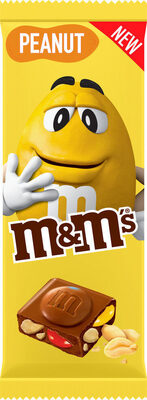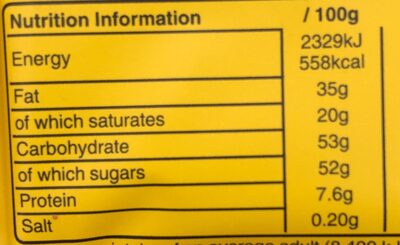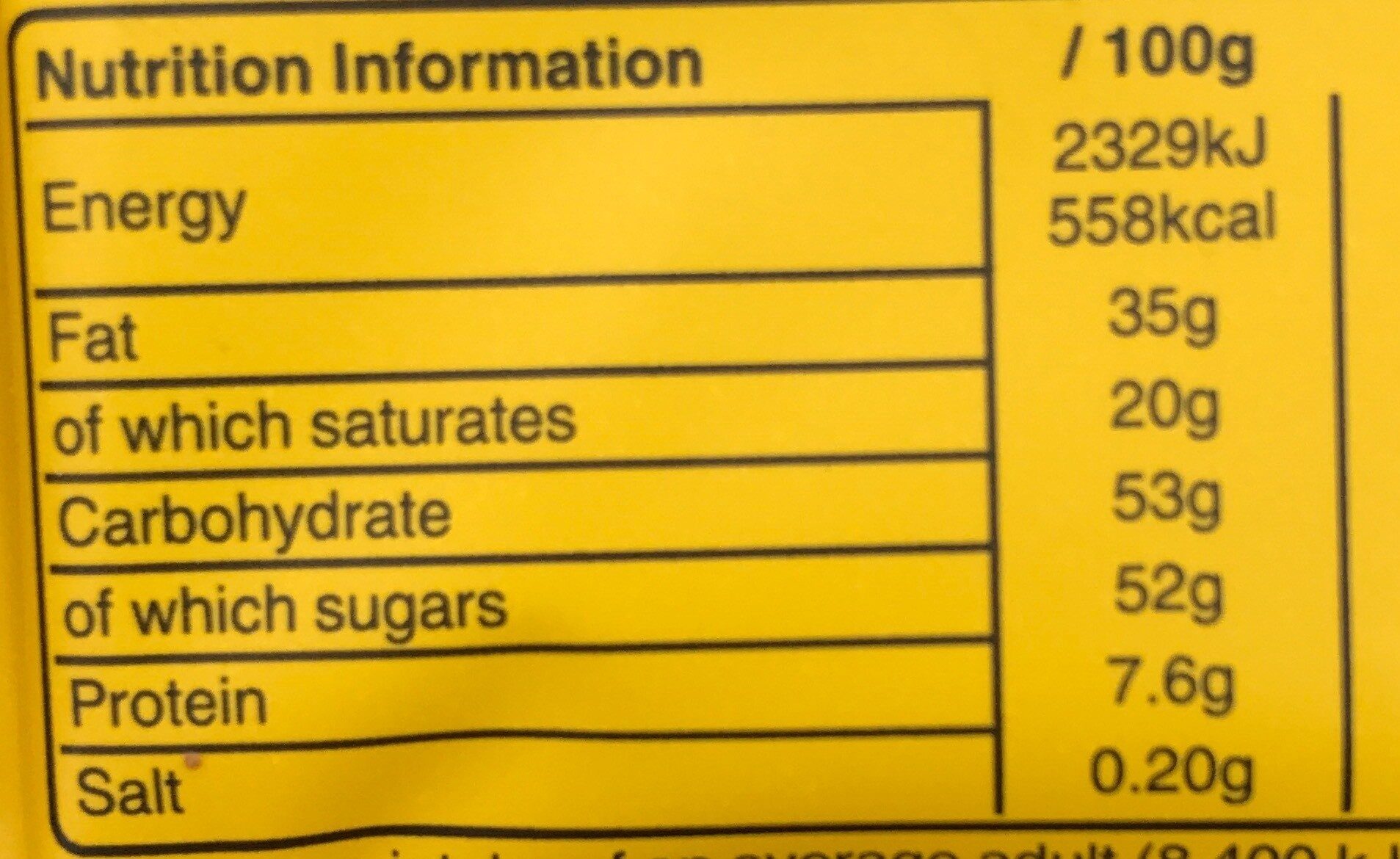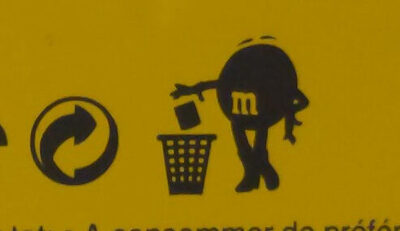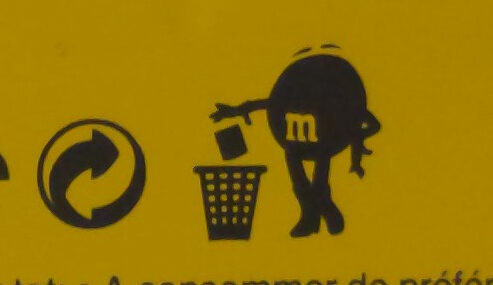Help us make food transparency the norm!
As a non-profit organization, we depend on your donations to continue informing consumers around the world about what they eat.
The food revolution starts with you!
M&M's peanut - 165 g
M&M's peanut - 165 g
This product page is not complete. You can help to complete it by editing it and adding more data from the photos we have, or by taking more photos using the app for Android or iPhone/iPad. Thank you!
×
Barcode: 5000159516235 (EAN / EAN-13)
Quantity: 165 g
Brandaí: M&M'S
Catagóirí: en:Snacks, en:Sweet snacks, en:Cocoa and its products, en:Confectioneries, en:Chocolate candies, en:Bonbons, en:Chocolates, en:Milk chocolates, en:Chocolate covered nuts, en:Chocolate covered peanuts
Labels, certifications, awards:
en:Green Dot
Siopaí: carrefour.fr, Continente
Country: An Fhrainc, An Ríocht Aontaithe
Matching with your preferences
Health
Comhábhair
-
31 ingredients
An Fhraincis: Sucre, beurre de cacao, lait écrémé en poudre, pâte de cacao, cacahuètes, matière grasse du lait, lactose, perméat de lactosérum (lait), lait entier en poudre, émulsifiant (lécithine de soja), matière grasse de palme, amidon, sirop de glucose, matière grasse de karité, stabilisant (gomme arabique), colorants (E100, E133, E160a, E162, E170, E172), dextrine, extrait de vanille, agent d'enrobage (cire de carnauba), huile de palmiste, sel, arôme.Hailléirginí: Bainne, Piseanna, Pónairí soigheTraces: Glútan
Food processing
-
Ultra processed foods
Elements that indicate the product is in the en:4 - Ultra processed food and drink products group:
- Additive: E100 - Curcumina
- Additive: E133 - Gorm lonrach FCF
- Additive: E1400 - Deistrin
- Additive: E160a
- Additive: E162
- Additive: E170
- Additive: E172
- Additive: E322
- Additive: E414
- Additive: E903
- Comhábhar: Dath
- Comhábhar: Eiblitheoir
- Comhábhar: Flavouring
- Comhábhar: Oibreán glónrúcháin
- Comhábhar: Glúcós
- Comhábhar: Glucose syrup
- Comhábhar: Lachtós
- Comhábhar: Whey
Food products are classified into 4 groups according to their degree of processing:
- Unprocessed or minimally processed foods
- Processed culinary ingredients
- Processed foods
- Ultra processed foods
The determination of the group is based on the category of the product and on the ingredients it contains.
Additives
-
E133 - Gorm lonrach FCF
Brilliant Blue FCF: Brilliant Blue FCF -Blue 1- is an organic compound classified as a triarylmethane dye and a blue azo dye, reflecting its chemical structure. Known under various commercial names, it is a colorant for foods and other substances. It is denoted by E number E133 and has a color index of 42090. It has the appearance of a blue powder. It is soluble in water, and the solution has a maximum absorption at about 628 nanometers.Source: Wikipedia (An Béarla)
-
E1400 - Deistrin
Deistrin: Siúcra coimpléascach, meascán de pholaiméirí glúcóis is ea an deistrin. Faightear í ó stáirse a bhristear síos le heinsímí nó téamh séimh. Úsáidtear deistriní mar oibreáin tiubhaithe i mbianna, agus greamacháin nó glónrú ar pháipéir is teicstílí. Ach is iad na feidhmeanna is mó a bhaintear astu bianna stáirsúla a dhéanamh nios blasta, agus an t-ualach osmóiseach ar an ngoile a laghdú i ndeochanna d'othair atá ag téarnamh.Source: Wikipedia
-
E160a
Caraitéin: Grúpa líocha a thugann na dathanna nádúrtha do chairéid, glasraí glasa, algaí, ribí róibéis is trátaí. Bíonn cuid mhaith béite-charaitéine i gcairéid is glasraí glasa, agus déántar vitimín A de suas le 16% di seo i gconair an bhia.Source: Wikipedia
-
E162
Betanin: Betanin, or Beetroot Red, is a red glycosidic food dye obtained from beets; its aglycone, obtained by hydrolyzing away the glucose molecule, is betanidin. As a food additive, its E number is E162. The color of betanin depends on pH; between four and five it is bright bluish-red, becoming blue-violet as the pH increases. Once the pH reaches alkaline levels betanin degrades by hydrolysis, resulting in a yellow-brown color. Betanin is a betalain pigment, together with isobetanin, probetanin, and neobetanin. Other pigments contained in beet are indicaxanthin and vulgaxanthins.Source: Wikipedia (An Béarla)
-
E170
Calcium carbonate: Calcium carbonate is a chemical compound with the formula CaCO3. It is a common substance found in rocks as the minerals calcite and aragonite -most notably as limestone, which is a type of sedimentary rock consisting mainly of calcite- and is the main component of pearls and the shells of marine organisms, snails, and eggs. Calcium carbonate is the active ingredient in agricultural lime and is created when calcium ions in hard water react with carbonate ions to create limescale. It is medicinally used as a calcium supplement or as an antacid, but excessive consumption can be hazardous.Source: Wikipedia (An Béarla)
-
E322
Lecithin: Lecithin -UK: , US: , from the Greek lekithos, "egg yolk"- is a generic term to designate any group of yellow-brownish fatty substances occurring in animal and plant tissues, which are amphiphilic – they attract both water and fatty substances -and so are both hydrophilic and lipophilic-, and are used for smoothing food textures, dissolving powders -emulsifying-, homogenizing liquid mixtures, and repelling sticking materials.Lecithins are mixtures of glycerophospholipids including phosphatidylcholine, phosphatidylethanolamine, phosphatidylinositol, phosphatidylserine, and phosphatidic acid.Lecithin was first isolated in 1845 by the French chemist and pharmacist Theodore Gobley. In 1850, he named the phosphatidylcholine lécithine. Gobley originally isolated lecithin from egg yolk—λέκιθος lekithos is "egg yolk" in Ancient Greek—and established the complete chemical formula of phosphatidylcholine in 1874; in between, he had demonstrated the presence of lecithin in a variety of biological matters, including venous blood, in human lungs, bile, human brain tissue, fish eggs, fish roe, and chicken and sheep brain. Lecithin can easily be extracted chemically using solvents such as hexane, ethanol, acetone, petroleum ether, benzene, etc., or extraction can be done mechanically. It is usually available from sources such as soybeans, eggs, milk, marine sources, rapeseed, cottonseed, and sunflower. It has low solubility in water, but is an excellent emulsifier. In aqueous solution, its phospholipids can form either liposomes, bilayer sheets, micelles, or lamellar structures, depending on hydration and temperature. This results in a type of surfactant that usually is classified as amphipathic. Lecithin is sold as a food additive and dietary supplement. In cooking, it is sometimes used as an emulsifier and to prevent sticking, for example in nonstick cooking spray.Source: Wikipedia (An Béarla)
-
E322i
Lecithin: Lecithin -UK: , US: , from the Greek lekithos, "egg yolk"- is a generic term to designate any group of yellow-brownish fatty substances occurring in animal and plant tissues, which are amphiphilic – they attract both water and fatty substances -and so are both hydrophilic and lipophilic-, and are used for smoothing food textures, dissolving powders -emulsifying-, homogenizing liquid mixtures, and repelling sticking materials.Lecithins are mixtures of glycerophospholipids including phosphatidylcholine, phosphatidylethanolamine, phosphatidylinositol, phosphatidylserine, and phosphatidic acid.Lecithin was first isolated in 1845 by the French chemist and pharmacist Theodore Gobley. In 1850, he named the phosphatidylcholine lécithine. Gobley originally isolated lecithin from egg yolk—λέκιθος lekithos is "egg yolk" in Ancient Greek—and established the complete chemical formula of phosphatidylcholine in 1874; in between, he had demonstrated the presence of lecithin in a variety of biological matters, including venous blood, in human lungs, bile, human brain tissue, fish eggs, fish roe, and chicken and sheep brain. Lecithin can easily be extracted chemically using solvents such as hexane, ethanol, acetone, petroleum ether, benzene, etc., or extraction can be done mechanically. It is usually available from sources such as soybeans, eggs, milk, marine sources, rapeseed, cottonseed, and sunflower. It has low solubility in water, but is an excellent emulsifier. In aqueous solution, its phospholipids can form either liposomes, bilayer sheets, micelles, or lamellar structures, depending on hydration and temperature. This results in a type of surfactant that usually is classified as amphipathic. Lecithin is sold as a food additive and dietary supplement. In cooking, it is sometimes used as an emulsifier and to prevent sticking, for example in nonstick cooking spray.Source: Wikipedia (An Béarla)
-
E414
Gum arabic: Gum arabic, also known as acacia gum, arabic gum, gum acacia, acacia, Senegal gum and Indian gum, and by other names, is a natural gum consisting of the hardened sap of various species of the acacia tree. Originally, gum arabic was collected from Acacia nilotica which was called the "gum arabic tree"; in the present day, gum arabic is collected from acacia species, predominantly Acacia senegal and Vachellia -Acacia- seyal; the term "gum arabic" does not indicate a particular botanical source. In a few cases so‐called "gum arabic" may not even have been collected from Acacia species, but may originate from Combretum, Albizia or some other genus. Producers harvest the gum commercially from wild trees, mostly in Sudan -80%- and throughout the Sahel, from Senegal to Somalia—though it is historically cultivated in Arabia and West Asia. Gum arabic is a complex mixture of glycoproteins and polysaccharides. It is the original source of the sugars arabinose and ribose, both of which were first discovered and isolated from it, and are named after it. Gum arabic is soluble in water. It is edible, and used primarily in the food industry as a stabilizer, with EU E number E414. Gum arabic is a key ingredient in traditional lithography and is used in printing, paint production, glue, cosmetics and various industrial applications, including viscosity control in inks and in textile industries, though less expensive materials compete with it for many of these roles. While gum arabic is now produced throughout the African Sahel, it is still harvested and used in the Middle East.Source: Wikipedia (An Béarla)
-
E903
Carnauba wax: Carnauba -; Portuguese: carnaúba [kaʁnɐˈubɐ]-, also called Brazil wax and palm wax, is a wax of the leaves of the palm Copernicia prunifera -Synonym: Copernicia cerifera-, a plant native to and grown only in the northeastern Brazilian states of Piauí, Ceará, Maranhão, Bahia, and Rio Grande do Norte. It is known as "queen of waxes" and in its pure state, usually comes in the form of hard yellow-brown flakes. It is obtained from the leaves of the carnauba palm by collecting and drying them, beating them to loosen the wax, then refining and bleaching the wax.Source: Wikipedia (An Béarla)
Ingredients analysis
-
en:Palm oil
Ingredients that contain palm oil: en:Palm fat, en:Palm kernel oil
-
en:Non-vegan
Non-vegan ingredients: en:Skimmed milk powder, en:Milkfat, Lachtós, en:Whey permeate, en:Whole milk powder
-
en:Vegetarian status unknown
Unrecognized ingredients: E170
-
Details of the analysis of the ingredients
fr: Sucre, beurre de cacao, lait écrémé en poudre, pâte de cacao, cacahuètes, matière grasse du lait, lactose, perméat de lactosérum, lait entier en poudre, émulsifiant (lécithine de soja), matière grasse de palme, amidon, sirop de glucose, matière grasse de karité, stabilisant (gomme arabique), colorants (e100, e133, e160a, e162, e170, e172), dextrine, extrait de vanille, agent d'enrobage (cire de carnauba), huile de palmiste, sel, arôme- Sucre -> en:sugar - vegan: yes - vegetarian: yes - ciqual_proxy_food_code: 31016 - percent_min: 4.54545454545455 - percent_max: 100
- beurre de cacao -> en:cocoa-butter - vegan: yes - vegetarian: yes - ciqual_food_code: 16030 - percent_min: 0 - percent_max: 50
- lait écrémé en poudre -> en:skimmed-milk-powder - vegan: no - vegetarian: yes - ciqual_food_code: 19054 - percent_min: 0 - percent_max: 33.3333333333333
- pâte de cacao -> en:cocoa-paste - vegan: yes - vegetarian: yes - ciqual_proxy_food_code: 16030 - percent_min: 0 - percent_max: 25
- cacahuètes -> en:peanut - vegan: yes - vegetarian: yes - ciqual_food_code: 15001 - percent_min: 0 - percent_max: 20
- matière grasse du lait -> en:milkfat - vegan: no - vegetarian: yes - from_palm_oil: no - percent_min: 0 - percent_max: 16.6666666666667
- lactose -> en:lactose - vegan: no - vegetarian: yes - percent_min: 0 - percent_max: 14.2857142857143
- perméat de lactosérum -> en:whey-permeate - vegan: no - vegetarian: maybe - percent_min: 0 - percent_max: 12.5
- lait entier en poudre -> en:whole-milk-powder - vegan: no - vegetarian: yes - ciqual_food_code: 19021 - percent_min: 0 - percent_max: 11.1111111111111
- émulsifiant -> en:emulsifier - percent_min: 0 - percent_max: 10
- lécithine de soja -> en:soya-lecithin - vegan: yes - vegetarian: yes - ciqual_food_code: 42200 - percent_min: 0 - percent_max: 10
- matière grasse de palme -> en:palm-fat - vegan: yes - vegetarian: yes - from_palm_oil: yes - ciqual_proxy_food_code: 16129 - percent_min: 0 - percent_max: 9.09090909090909
- amidon -> en:starch - vegan: yes - vegetarian: yes - ciqual_proxy_food_code: 9510 - percent_min: 0 - percent_max: 8.33333333333333
- sirop de glucose -> en:glucose-syrup - vegan: yes - vegetarian: yes - ciqual_proxy_food_code: 31016 - percent_min: 0 - percent_max: 7.69230769230769
- matière grasse de karité -> en:shea-butter - vegan: yes - vegetarian: yes - from_palm_oil: no - ciqual_food_code: 16110 - percent_min: 0 - percent_max: 7.14285714285714
- stabilisant -> en:stabiliser - percent_min: 0 - percent_max: 6.66666666666667
- gomme arabique -> en:e414 - vegan: yes - vegetarian: yes - percent_min: 0 - percent_max: 6.66666666666667
- colorants -> en:colour - percent_min: 0 - percent_max: 6.25
- e100 -> en:e100 - vegan: yes - vegetarian: yes - percent_min: 0 - percent_max: 6.25
- e133 -> en:e133 - vegan: yes - vegetarian: yes - percent_min: 0 - percent_max: 3.125
- e160a -> en:e160a - vegan: maybe - vegetarian: maybe - from_palm_oil: maybe - percent_min: 0 - percent_max: 2.08333333333333
- e162 -> en:e162 - vegan: yes - vegetarian: yes - percent_min: 0 - percent_max: 1.5625
- e170 -> en:e170 - percent_min: 0 - percent_max: 1.25
- e172 -> en:e172 - vegan: yes - vegetarian: yes - percent_min: 0 - percent_max: 1.04166666666667
- dextrine -> en:e1400 - vegan: yes - vegetarian: yes - percent_min: 0 - percent_max: 5.88235294117647
- extrait de vanille -> en:vanilla-extract - vegan: yes - vegetarian: yes - ciqual_food_code: 11065 - percent_min: 0 - percent_max: 5.55555555555556
- agent d'enrobage -> en:glazing-agent - percent_min: 0 - percent_max: 5.26315789473684
- cire de carnauba -> en:e903 - vegan: yes - vegetarian: yes - percent_min: 0 - percent_max: 5.26315789473684
- huile de palmiste -> en:palm-kernel-oil - vegan: yes - vegetarian: yes - from_palm_oil: yes - percent_min: 0 - percent_max: 5
- sel -> en:salt - vegan: yes - vegetarian: yes - ciqual_food_code: 11058 - percent_min: 0 - percent_max: 0.23
- arôme -> en:flavouring - vegan: maybe - vegetarian: maybe - percent_min: 0 - percent_max: 0.23
Nutrition
-
Bad nutritional quality
⚠ ️Warning: the amount of fiber is not specified, their possible positive contribution to the grade could not be taken into account.⚠ ️Warning: the amount of fruits, vegetables and nuts is not specified on the label, it was estimated from the list of ingredients: 2This product is not considered a beverage for the calculation of the Nutri-Score.
Positive points: 0
- Próitéiní: 0 / 5 (value: 0.0083, rounded value: 0.01)
- Fiber: 0 / 5 (value: 0, rounded value: 0)
- Fruits, vegetables, nuts, and colza/walnut/olive oils: 0 / 5 (value: 2.98295454545455, rounded value: 3)
Negative points: 27
- Energy: 6 / 10 (value: 2295, rounded value: 2295)
- Siúcraí: 10 / 10 (value: 53, rounded value: 53)
- Saturated fat: 10 / 10 (value: 19, rounded value: 19)
- Sodium: 1 / 10 (value: 92, rounded value: 92)
The points for proteins are not counted because the negative points are greater or equal to 11.
Nutritional score: (27 - 0)
Nutri-Score:
-
Nutrient levels
-
Saill as high quantity (33%)
What you need to know- A high consumption of fat, especially saturated fats, can raise cholesterol, which increases the risk of heart diseases.
Recommendation: Limit the consumption of fat and saturated fat- Choose products with lower fat and saturated fat content.
-
SáSitheáin saill as high quantity (19%)
What you need to know- A high consumption of fat, especially saturated fats, can raise cholesterol, which increases the risk of heart diseases.
Recommendation: Limit the consumption of fat and saturated fat- Choose products with lower fat and saturated fat content.
-
Siúcraí as high quantity (53%)
What you need to know- A high consumption of sugar can cause weight gain and tooth decay. It also augments the risk of type 2 diabetes and cardio-vascular diseases.
Recommendation: Limit the consumption of sugar and sugary drinks- Sugary drinks (such as sodas, fruit beverages, and fruit juices and nectars) should be limited as much as possible (no more than 1 glass a day).
- Choose products with lower sugar content and reduce the consumption of products with added sugars.
-
Salann as cainníocht íseal (0.23%)
What you need to know- A high consumption of salt (or sodium) can cause raised blood pressure, which can increase the risk of heart disease and stroke.
- Many people who have high blood pressure do not know it, as there are often no symptoms.
- Most people consume too much salt (on average 9 to 12 grams per day), around twice the recommended maximum level of intake.
Recommendation: Limit the consumption of salt and salted food- Reduce the quantity of salt used when cooking, and don't salt again at the table.
- Limit the consumption of salty snacks and choose products with lower salt content.
-
-
Nutrition facts
Nutrition facts As sold
for 100 g / 100 mlCompared to: en:Chocolate covered peanuts Fuinneamh 2,295 kj
(550 kcal)+5% Saill 33 g +17% SáSitheáin saill 19 g +60% Carbaihiodráit 54 g +4% Siúcraí 53 g +13% Snáithín ? Próitéin 0.008 g -100% Salann 0.23 g +107% Fruits‚ vegetables‚ nuts and rapeseed‚ walnut and olive oils (estimate from ingredients list analysis) 2.983 %
Environment
-
Eco-Score E - Very high environmental impact
The Eco-Score is an experimental score that summarizes the environmental impacts of food products.→ The Eco-Score was initially developped for France and it is being extended to other European countries. The Eco-Score formula is subject to change as it is regularly improved to make it more precise and better suited to each country.Life cycle analysis
-
Average impact of products of the same category: C (Score: 42/100)
Catagóir: Sugar and chocolate coated peanut
Catagóir: Sugar and chocolate coated peanut
- PEF environmental score: 0.69 (the lower the score, the lower the impact)
- including impact on climate change: 9.59 kg CO2 eq/kg of product
Stage Impact Agriculture
83.5 %Processing
9.9 %Packaging
1.5 %Transportation
4.4 %Distribution
0.7 %Consumption
0.0 %
Bonuses and maluses
-
Missing origins of ingredients information
Malus: -5
⚠ ️ The origins of the ingredients of this product are not indicated.
If they are indicated on the packaging, you can modify the product sheet and add them.
If you are the manufacturer of this product, you can send us the information with our free platform for producers.
-
Ingredients that threatens species
Malus: -10
Contains palm oil
Tropical forests in Asia, Africa and Latin America are destroyed to create and expand oil palm tree plantations. The deforestation contributes to climate change, and it endangers species such as the orangutan, the pigmy elephant and the Sumatran rhino.
-
Packaging with a medium impact
Malus: -10
Shape Material Recycling Impact 1 Bag Plastic Discard Ard
Eco-Score for this product
-
Impact for this product: E (Score: 17/100)
Táirge: M&M's peanut - 165 g
Life cycle analysis score: 42
Sum of bonuses and maluses: -25
Final score: 17/100
-
Carbon footprint
-
Equal to driving 5.0 km in a petrol car
959 g CO² per 100g of product
The carbon emission figure comes from ADEME's Agribalyse database, for the category: Sugar and chocolate coated peanut (Source: ADEME Agribalyse Database)
Stage Impact Agriculture
89.5 %Processing
6.0 %Packaging
1.1 %Transportation
3.3 %Distribution
0.2 %Consumption
0.0 %
Packaging
-
Packaging with a medium impact
-
Packaging parts
1 x Bag (Plastic)
-
Packaging materials
Material % Packaging weight Packaging weight per 100 g of product Plastic
-
Transportation
-
Origins of ingredients
Missing origins of ingredients information
⚠ ️ The origins of the ingredients of this product are not indicated.
If they are indicated on the packaging, you can modify the product sheet and add them.
If you are the manufacturer of this product, you can send us the information with our free platform for producers.Add the origins of ingredients for this product Add the origins of ingredients for this product
Threatened species
-
Contains palm oil
Drives deforestation and threatens species such as the orangutan
Tropical forests in Asia, Africa and Latin America are destroyed to create and expand oil palm tree plantations. The deforestation contributes to climate change, and it endangers species such as the orangutan, the pigmy elephant and the Sumatran rhino.
Report a problem
-
Incomplete or incorrect information?
Category, labels, ingredients, allergens, nutritional information, photos etc.
If the information does not match the information on the packaging, please complete or correct it. Open Food Facts is a collaborative database, and every contribution is useful for all.
Data sources
Product added on ag kiliweb
Last edit of product page on ag foodless.
Product page also edited by ansojd, chevalstar, date-limite-app, driveoff, ecoscore-impact-estimator, fabi2, foodvisor, hungergames, inf, marunsky, melmarce, openfoodfacts-contributors, pyrka, quechoisir, roboto-app, teolemon, thaialagata, vaporous, yuka.SEpnNFRhUXNvYVEyZ3YwMDJFN295czFVd2JDaVkzR3JHYllOSWc9PQ, yuka.sY2b0xO6T85zoF3NwEKvlnIYY8byk2_bHj3joBCxydXTHrW5Wusps6boYqo.
